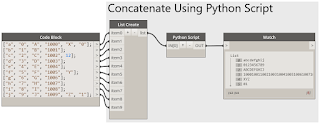A List Create node is still necessary to make a single list of lists to serve as the input, so that the Python Script node need only have one input, but the List.Transpose and List.Flatten nodes can be eliminated.
The Python code is fairly straightforward.
- The input list of strings is assigned to lstInput, and lstOutput is set up as an empty list, to receive the list of concatenated strings, which will be the output of the node.
- A for statement examines the length of each of the sublists in lstInput, to determine the maximum list length (maxLength). This is used to set the number of times the concatenation code needs to be run: once for every item in the longest list.
- An index counter, iIndex, is initialized to the first index, 0.
- A while statement is used to process the lists, once for each item on the longest list.
- On each pass through the while code, a variable to hold the concatenated string from that pass (strConcat) is initialized as an empty string.
- Then, for each sublist in lstInput, strX is set to the string at the current index being processed. This is done in a try statement, so that the code does not fail when a shorter list has no item at the current index. If a value is returned, an if statement verifies that it is a string. If not, strX is reset to an empty string. If a value is not returned to strX, the except statement sets strX to an empty string.
- The string value in strX is then added to the end of strConcat, and the for statement is rerun for the next sublist, until all sublists have been processed.
- With the fully processed concatenated string in hand, an if statement checks the value, to see if it remains an empty string. If not, the string is appended to lstOutput. If it is empty, no action is taken.
- Finally, the index counter (iIndex) is incremented, and the while statement is run again, provided that iIndex remains less than the length of the longest sublist (maxLength).
- Once the while statement has been run once for each item in the longest list, the list of concatenated strings in lstOutput is sent to the output of the node.


No comments:
Post a Comment